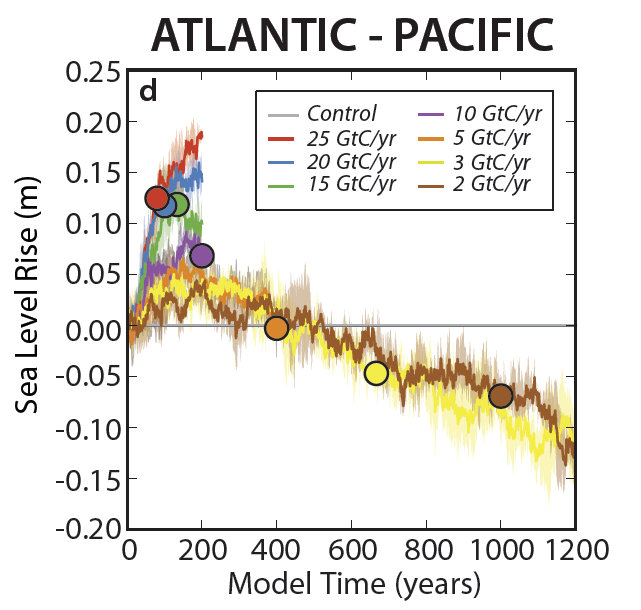February 1st, 2016
Key Findings
- Basin-scale asymmetries in ocean heat uptake and sea level rise are sensitive to both the cumulative and rate of greenhouse gas emissions.
- Emission rates greater than 5 GtC yr-1 enhance Atlantic sea level rise relative to the Pacific on centennial time scales, related to reduced Atlantic basin ventilation and weaker overturning processes. For reference, present day carbon emission rates are ~10 GtC yr-1.
- Low emission rates (2 and 3 GtC yr-1) produce more uniform sea level rise during the first several centuries before the Pacific sea level rise overtakes the Atlantic on millennial time scales.
- For a given level of cumulative carbon emissions and on multi-century time scales, the largest sea level rise occurs under low emission rates.
- While this combined sensitivity complicates the relationship between cumulative emissions and full-column heat uptake and sea level rise, the relationship between cumulative emissions and upper ocean (0-700m) Atlantic-Pacific temperature differences appears robust to variability in emission rate.
J. P. Krasting, J. P. Dunne, R. J. Stouffer, and R. W. Hallberg. Accepted to Nature Geoscience
Summary
Recent observational studies indicate that more than 90% of the anthropogenically-generated heat anomaly generated between 1971 and 2010 has gone into warming the oceans. Furthermore, the Atlantic basin is warming faster than the Pacific. This study demonstrates that basin scale differences in heat uptake and sea level rise are a forced response from increasing atmospheric carbon dioxide concentrations, and the inter-basin differences vary with emission rate (see figure). Weaker overturning circulations in the Atlantic in the higher emission scenarios (i.e. > 5 GtC yr-1) make the ocean interior both warmer and less ventilated and are associated with enhanced Atlantic sea level rise, relative to the Pacific. The basin scale differences in sea level rise that vary with emission rate are relevant to climate adaptation efforts because they illustrate the relative vulnerability of the Atlantic to high emission rates and demonstrate that global average metrics of sea level rise could become less representative of regional scale changes.
The authors used a fully-coupled emission-driven climate-carbon-cycle model, GFDL-ESM2G, forced with 7 different idealized carbon emission rates ranging between 2 and 25 GtC yr. These were similar to the range of carbon emissions at year 2100 across all of the Representative Concentration Pathways (RCPs) used in IPCC AR5. Three ensemble members of each scenario were integrated to at least a doubling of atmospheric preindustrial CO2 concentrations. Combined with a 1200 year control run, a total of 120,000 model years were analyzed in this study. Centennial scale drift in GFDL-ESM2G, was accounted for by subtracting fields obtained from the perturbation runs from the 100-year smoothed fields from the control run.
While this study has focused on basin-scale sea level rise, it is important to note other factors that have significant contributions to the sea level rise in the real world. These include geoid changes, glacial isostatic adjustment, as well as freshwater mass contributions from melting land ice. The details of our results may vary depending on the individual model representation of AMOC and the associated ventilation time scales among the world’s ocean basins. The results may also depend on ocean mixing and the equilibrium climate sensitvity which may vary from model to model. Variations in heat uptake efficiency and thermal expansion efficiency across models could also impact these results. Although individual models may vary based on all of these factors, the results of this study are potentially reproducible in the CMIP5 multi-model ensemble, mainly since AMOC weakening is a robust response to anthropogenic climate warming.



